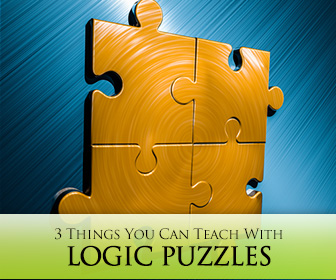
Puzzles are always a good time.
OK, not always, but most of the time, and logic puzzles are a great way to challenge your students. You can find various logic puzzles on the internet or can make your own. Making your own logic puzzles can be a very time consuming and difficult process, especially if you are not overly familiar with how these usually work. Modelling them after the Einstein Puzzle is probably the best method. It is also usually best to supply your students with a grid style worksheet so they can work though the answers piece by piece as well as a table where they can write their final answer. This helps students keep track of their reasoning and remember what questions they are actually trying to answer.
When you are having your students complete these puzzles, remember that this is partially about how your mind works. Even native speakers can find these difficult so it is probably best to let them discuss the clues in their own language. They will have to keep coming back to reading and understanding the English clues to actually make headway on solving the puzzle. Be aware that these are not primarily speaking activities. Also, these are not activities that you complete in the last twenty minutes of class. In my experience, even my highest level classes needed the full forty minutes for one or two groups to finish a low/mid-level logic puzzle. This is a best done as a group project so the high level students can help the others fully understand the clues.
If you want to incorporate some speaking into this you can give each group only some of the clues they need. Then some group members must go to the other groups, ask for a clue, listen carefully, write it down, and take it back to their own group. Depending on the level and behaviour of your students you can insist they ask specific questions (ie. do you have any clues about Stephanie) and that only one member from each group can be standing at any one time.

Incorporate Logic Puzzles into Lessons Successfully
-
1
Close Reading
Logic puzzles are fantastic for getting students to really concentrate on what they are reading. Obviously, teachers must ensure that the students have been taught the necessary vocabulary and sentence structures to understand the clues, but having to apply it in a logic puzzle situation forces them to really pay attention to the implications of each word and sentence. When explaining the project, encourage the students to read through all the clues first, then go back and mark off all the obvious information on their answer sheet. Suggest that on the third read through they pause after each clue and discuss with their group exactly what the full meaning and implications of the sentence might be. Does it have underlying implied meaning beyond what is stated in the actual sentence? Once they have milked each individual clue for what it can tell them, they need to start comparing the different clues and see what they reveal when used together. It is probably worth suggesting, either at the beginning of class or partway through that they try grouping clues that all discuss the same category of information (ie. height) together and see what information that reveals.
Ultimately, completing a logic puzzle is about reading and fully understanding each clue in its own right, how it relates to the other clues that are given, and what the final, cumulative meaning of all this writing might be. Logic puzzles use all the important elements of close reading comprehension.
-
2
The Conditional
At its heart, solving a logic puzzle relies completely on conditional reasoning. If x then y. If Jamie is taller than Kelly, Jamie cannot be the shortest person and Kelly cannot be the tallest person. Teachers who are using logic puzzles to practice the conditional may want to consider completing a simple logic puzzle as a class in one lesson and then having the groups do their own logic puzzles in another lesson.
For example, in the first lesson divide the students into their groups and give each group an even number of the clues. The teacher can then call on each group in turn to read out one of their clues. After each clue is read, solicit conditional clauses from the class at large. To help keep all the clues in front of the class, teachers may want to print very large copies that can be put up on the board once they have been read out by the group. This requires a very simple puzzle as the process of reading the clues and then composing conditional sentences will be very time consuming.
In the second class, give each group their own, more complex logic puzzle to solve. Follow the same process as in the close reading explanation and then allow the students to work through and solve the puzzle. It may be necessary to assign it as homework if the students are not finished by the end of class. Alternatively, the teacher can, while circulating, help keep all the groups at roughly the same level by assisting those who get stuck. The following class, have the students work in their groups and compose at least one conditional sentence for every conclusion they have reached. So, let’s say the students have concluded that Janet is the shortest person. They would then create a conditional sentence referencing at least one clue they used to draw their conclusions. Depending on the complexity of the puzzle this may take a large portion of the class. To practice speaking, have the groups take turns reading their conditional sentences.
-
3
Physical Descriptions
Many logic puzzles rely on distinguishing characteristics of the people involved in the situations to resolve them. Clues such as ‘the girl with blonde hair is taller than the boy with black hair’ are very common. Tied into physical appearance is the use of comparatives and superlatives. Again, these are a key part of most logic puzzle clues involving people, races, houses, pets, etc. Distinguishing between them requires knowing which are bigger, taller, faster, smallest, etc. Depending on what material you taught your students, you may want to make your own logic puzzle for this application. Making your own would enable you to ensure that all the phrases and vocabulary you taught are actually used in the clues.
As the final activity, you can require that each group create a pictorial representation of the solution with each person’s defining characteristics. This allows you to touch on the various aspects of physical appearance as well as test their knowledge of comparatives and superlatives. And let’s face it, students love activities that allow them to make posters.
Logic puzzles are great teaching tools with a wide variety of applications.
Indeed, they don’t necessarily need to be tied to a single teaching point. They are great activities for those weeks between final exams and the end of the school year. Students stay interested, there is almost no teacher-talk-time, and you can offer up prizes for the first to get the correct answer, the best conditional sentence, or the best pictorial representation of the solution. Basically, logic puzzles, while educational, are also fun for all!
P.S. If you enjoyed this article, please help spread it by clicking one of those sharing buttons below. And if you are interested in more, you should follow our Facebook page where we share more about creative, non-boring ways to teach English.







